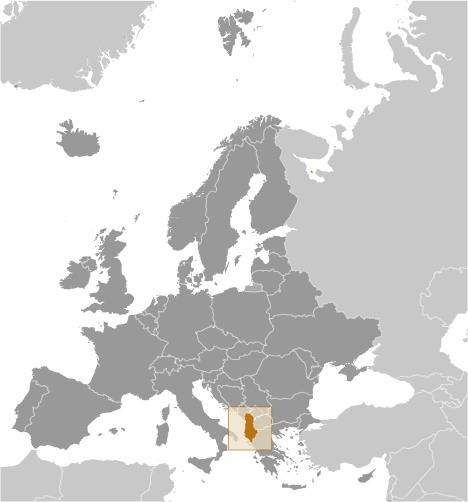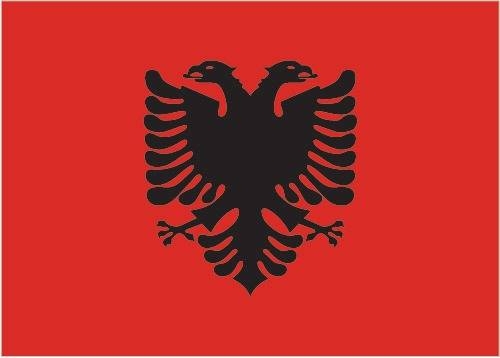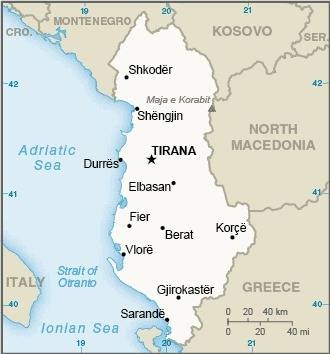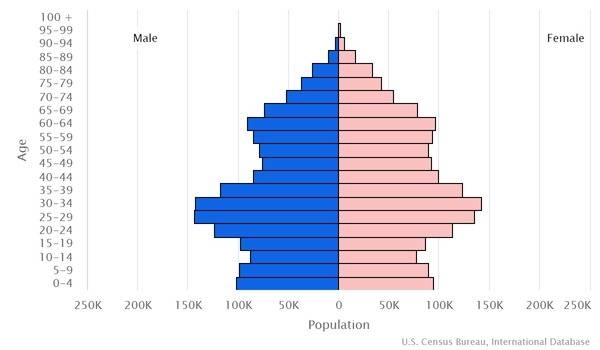Country Summary




Introduction
Background
In the early 1990s, Albania ended 46 years of isolated communist rule and established a multiparty democracy. A large informal economy and a weak energy and transportation infrastructure remain obstacles
Geography
Area
total: 28,748 sq km
land: 27,398 sq km
water: 1,350 sq km
Climate
mild temperate; cool, cloudy, wet winters; hot, clear, dry summers; interior is cooler and wetter
Natural resources
petroleum, natural gas, coal, bauxite, chromite, copper, iron ore, nickel, salt, timber, hydropower, arable land
People and Society
Population
3,095,344 (2022 est.)
Ethnic groups
Albanian 82.6%, Greek 0.9%, other 1% (including Vlach, Romani, Macedonian, Montenegrin, and Egyptian), unspecified 15.5% (2011 est.)
Languages
Albanian 98.8% (official - derived from Tosk dialect), Greek 0.5%, other 0.6% (including Macedonian, Romani, Vlach, Turkish, Italian, and Serbo-Croatian), unspecified 0.1% (2011 est.)
Religions
Muslim 56.7%, Roman Catholic 10%, Orthodox 6.8%, atheist 2.5%, Bektashi (a Sufi order) 2.1%, other 5.7%, unspecified 16.2% (2011 est.)
Population growth rate
0.22% (2022 est.)
Government
Government type
parliamentary republic
Capital
name: Tirana (Tirane)
Executive branch
chief of state: President of the Republic Bajram BEGAJ (since 24 July 2022)
head of government: Prime Minister Edi RAMA (since 10 September 2013); Deputy Prime Minister Arben AHMETAJ (since 18 September 2021)
Legislative branch
description: unicameral Assembly or Kuvendi (140 seats; members directly elected in multi-seat constituencies by proportional representation vote to serve 4-year terms)
Economy
Economic overview
future hopeful EU member state; oil and gas exporter but investing toward a “blue economy”; COVID-19 and earthquake economic disruptions and declines; experiencing high debt and account balances; strengthening private sector growth and public sector trust
Real GDP (purchasing power parity)
$37.73 billion (2020 est.)
Real GDP per capita
$13,300 (2020 est.)
Agricultural products
milk, maize, tomatoes, potatoes, watermelons, wheat, grapes, cucumbers, onions, apples
Industries
food; footwear, apparel and clothing; lumber, oil, cement, chemicals, mining, basic metals, hydropower
Exports
$3.47 billion (2020 est.)
Exports - partners
Italy 45%, Spain 8%, Germany 6%, Greece 5%, France 4%, China 4% (2019)
Exports - commodities
leather footwear and parts, crude petroleum, iron alloys, clothing, electricity, perfumes (2019)
Imports
$5.67 billion (2020 est.)
Imports - partners
Italy 28%, Greece 12%, China 11%, Turkey 9%, Germany 5% (2019)
Imports - commodities
refined petroleum, cars, tanned hides, packaged medical supplies, footwear parts (2019)
Exchange rates
leke (ALL) per US dollar -
Page last updated: Wednesday, November 16, 2022
